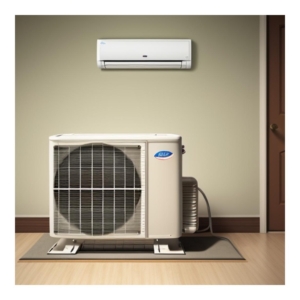Ductless Mini-Split vs Central HVAC: Which is Right for Your Home?

When we aim to make our homes the perfect retreat, having a good heating and cooling system is incredibly important.
These systems do more than just change the temperature – they are key to creating a cozy living space that takes care of our physical comfort and emotional well-being. Think about how nice it would be to walk into a warm and snug home when it’s cold outside, or to step into a refreshingly cool home on a super hot day.
These are the kinds of experiences a well-designed heating and cooling system can offer. But it’s not just about feeling comfy right away; these systems also help keep the air inside clean, control moisture levels, and save energy, all of which shape a home that suits our lifestyle and makes our life better overall.
We’re going to break down two of the common types of cooling and heating systems: ductless mini-split and central HVAC.
Ductless Mini-Split vs. Central HVAC: What’s the Difference
- Ductless mini-splits are like personalized comfort machines. They consist of an outdoor unit linked to one or more indoor units. These indoor units can be set up in different rooms, allowing you to control temperatures individually. They’re excellent for homes without ductwork and offer flexibility in zoning.
- Central HVAC systems are the more traditional approach. They use a network of ducts to circulate treated air throughout the house. A central unit, often placed outside, manages the air and sends it through ducts to reach various rooms. While they provide consistent temperatures, ducts can sometimes lead to energy loss. Both systems have their pros and cons, so choosing between them depends on your specific needs and the layout of your home.
Understanding Ductless Mini-Split Systems
Picture this: instead of relying on a network of ducts to deliver air, ductless mini-splits offer a more direct path. They consist of two main parts – an outdoor unit and one or more indoor units. These indoor units can be mounted on walls or ceilings, making them a versatile option. The magic happens through refrigerant lines that connect the outdoor and indoor units.
These systems provide precise temperature control for different zones, meaning you can keep your bedroom cooler than your living room, for example.
Plus, since they don’t rely on ducts, there’s less energy loss, potentially saving you on utility bills. If you’re looking to bring tailored comfort to your home without the need for extensive ductwork, ductless mini-splits could be your answer.
Understanding Central HVAC Systems
Let’s unravel the workings of central HVAC systems – the heartbeat of many homes when it comes to keeping things comfy. These systems are like the air traffic controllers of your indoor environment, ensuring a consistent temperature throughout your living spaces.
Here’s how they operate: a central unit, usually situated outside your home, takes charge of treating the air. This treated air then travels through a series of ducts, like secret passageways within your walls and ceilings, to reach every room.
This method is effective for maintaining a stable temperature, but it can have its drawbacks, such as potential energy loss due to leaky ducts. Central HVAC systems are like the orchestra conductors of your home’s comfort, but remember, proper maintenance and sealing those ducts can make a significant difference in their performance and efficiency.
Factors to Consider When Choosing Ductless Mini-Split Systems or Central HVAC Systems
Installation
- Ductless Mini-Split Systems: These systems are relatively easy to install compared to central HVAC systems. They consist of an outdoor unit connected to one or more indoor units. The indoor units can be mounted on walls or ceilings and require only a small hole for the refrigerant lines and cables to pass through. This makes them a good choice for homes without existing ductwork.
- Central HVAC Systems: These systems involve ductwork that distributes air throughout your home. If your home doesn’t already have ducts, installing them can be a major undertaking. It might involve opening up walls and ceilings, which can be time-consuming and costly.
Flexibility
- Ductless Mini-Split Systems: These systems allow you to create different zones in your home. Each indoor unit can be controlled separately, allowing you to customize the temperature in different rooms. This can help save energy and make everyone in your home comfortable.
- Central HVAC Systems: While you can have some level of control over different areas with a central system, it might not be as precise as with mini-splits. You might find that certain areas are warmer or cooler than others due to variations in ductwork and airflow.
Energy Efficiency
- Ductless Mini-Split Systems: These systems are known for their energy efficiency. Because each indoor unit is controlled separately, you can turn off units in rooms that aren’t being used, saving energy. Additionally, the absence of ducts eliminates the energy loss that can occur in central systems through leaky ducts.
- Central HVAC Systems: Energy efficiency can vary based on the quality of the ductwork and the overall system. Well-designed and properly sealed ducts are important to prevent energy wastage.
Aesthetics
- Ductless Mini-Split Systems: The indoor units of mini-splits are visible in each room. While modern units are designed to be sleek and less obtrusive, some people might not like the appearance of these units on their walls or ceilings.
- Central HVAC Systems: Since the ducts are hidden in the walls and ceilings, central systems are more discreet. You won’t see the equipment in each room, which can contribute to a cleaner aesthetic.
Cost
- Ductless Mini-Split Systems: These systems tend to have a lower upfront cost, especially if you’re not dealing with existing ductwork. The cost will depend on the number of indoor units you need and the complexity of the installation.
- Central HVAC Systems: The initial cost can be higher due to the need for duct installation. However, in the long run, they might be more cost-effective for larger homes because they are designed to handle whole-house heating and cooling.
Conclusion
Ductless Mini-Split and Central HVAC systems tirelessly maintain air quality, manage humidity, and conserve energy, culminating in a living space tailored to our lifestyle and enhancing our overall quality of life.
Ductless mini-splits craft personalized zones of warmth or coolness through versatile setups, while central HVAC systems function as architects of consistent comfort through intricate networks of ducts.
Factors like ease of installation, flexibility, energy efficiency, aesthetics, and cost form the fabric of decision-making in the realm of home climate management. Ductless mini-splits promise customized comfort zones, while central HVAC systems boast comprehensive control. Your choice hinges on your household’s unique needs and your living space layout. As you embark on the journey of selecting the ideal climate companion for your home, remember that this decision isn’t merely about a system – it’s about crafting a sanctuary where comfort, well-being, and tranquility converge harmoniously.
Looking for answers on which system is best for you and your home? Our Comfort Advisors can not only answer them but give you an accurate quote of what the cost associated with the best system for your home is.

 Jacobs and Rhodes
Jacobs and Rhodes Jacobs and Rhodes
Jacobs and Rhodes